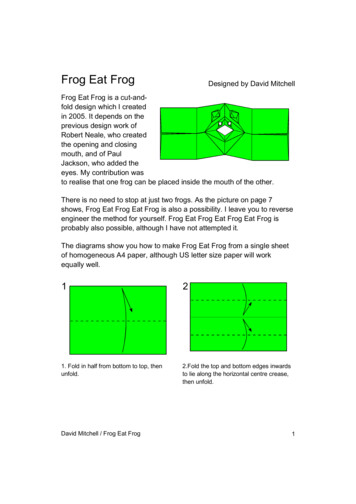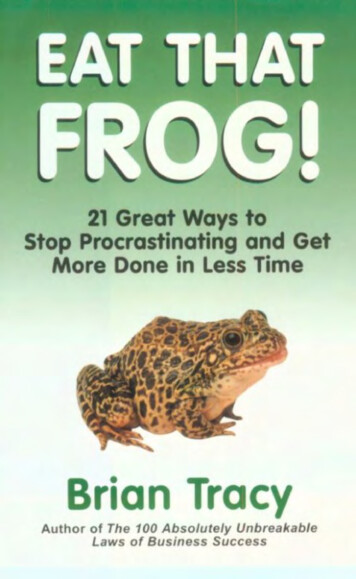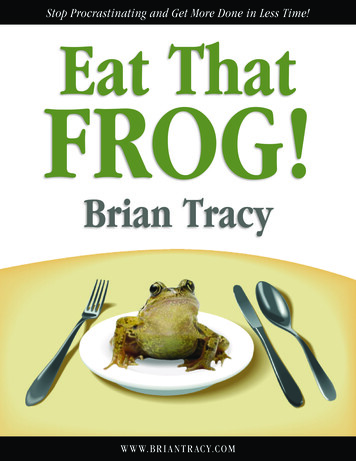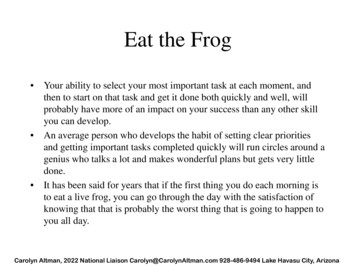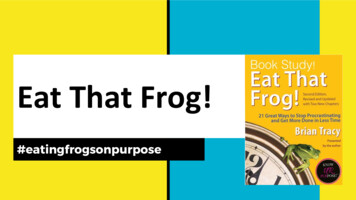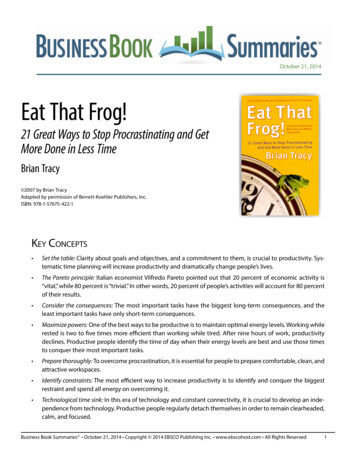
Transcription
October 21, 2014Eat That Frog!21 Great Ways to Stop Procrastinating and GetMore Done in Less TimeBrian Tracy 2007 by Brian TracyAdapted by permission of Berrett-Koehler Publishers, Inc.ISBN: 978-1-57675-422-1Key Concepts Set the table: Clarity about goals and objectives, and a commitment to them, is crucial to productivity. Systematic time planning will increase productivity and dramatically change people’s lives. The Pareto principle: Italian economist Vilfredo Pareto pointed out that 20 percent of economic activity is“vital,” while 80 percent is “trivial.” In other words, 20 percent of people’s activities will account for 80 percentof their results. Consider the consequences: The most important tasks have the biggest long-term consequences, and theleast important tasks have only short-term consequences. Maximize powers: One of the best ways to be productive is to maintain optimal energy levels. Working whilerested is two to five times more efficient than working while tired. After nine hours of work, productivitydeclines. Productive people identify the time of day when their energy levels are best and use those timesto conquer their most important tasks. Prepare thoroughly: To overcome procrastination, it is essential for people to prepare comfortable, clean, andattractive workspaces. Identify constraints: The most efficient way to increase productivity is to identify and conquer the biggestrestraint and spend all energy on overcoming it. Technological time sink: In this era of technology and constant connectivity, it is crucial to develop an independence from technology. Productive people regularly detach themselves in order to remain clearheaded,calm, and focused.Business Book Summaries October 21, 2014 Copyright 2014 EBSCO Publishing Inc. www.ebscohost.com All Rights Reserved1
Eat That Frog! Brian TracySlice and dice: A good way to prevent procrastination is to slice up big tasks into smaller tasks. Completingone slice motivates people to complete the next slice, and soon their tasks are finished. Humans have a“compulsion to closure,” which means they are more fulfilled when they complete things.IntroductionAs Brian Tracy explains in Eat That Frog!, options abound in life, but so does procrastination. People simplycannot do everything they need or want to do. Instead of attempting to complete everything, productivepeople select the most important things and prioritize them. Mark Twain said that if people eat frogs first thingin the morning, it will be the worst thing they do all day. Like eating frogs, the most important tasks people havefor the day should be completed first. This boosts self-esteem and energy, ignites the desire to complete thenext task, and becomes a positive addiction that leads to a productive, fulfilling way of life.Set the TableA major cause of procrastination is a lack of clear vision about what people want to achieve. Clarity about goalsand objectives, and a commitment to them, is crucial to productivity. Seven steps will help individuals increasetheir productivity. They must:1. Decide exactly what they want.2. Set deadlines.3. List everything they need to achieve their goals.4. Make plans.5. Take action.6. Do something every single day.The number one reason why some peopleget more work donefaster is because theyare absolutely clearabout their goals andobjectives, and theydon’t deviate fromthem.Productive people decide on clear goals, write them down to give them tangible forms, set deadlines to produce urgency, write down any activities thatwill contribute to those goals, devise plans that prioritize their lists and breaksthem down into individual tasks, and execute plans daily. Goals are the keyto fueling the desire for achievement. Productive people make monthly lists, weekly lists, and daily lists beforetheir months, weeks, and days even begin. Systematic time planning increases productivity and can dramatically change people’s lives. Every minute of planning saves ten minutes of work. Checking off completed tasksthroughout the day motivates people and raises their self-esteem, granting them the energy to complete moretasks.One helpful rule to apply is the “Pareto Principle,” or the “80/20” rule. Italian economist Vilfredo Pareto pointedout that 20 percent of economic activity is “vital,” while 80 percent is “trivial.” He claimed that 20 percent ofpeople’s activities actually account for 80 percent of their results. This means that for a list of ten items, two willbe paramount, counting five to ten times more than the rest of the list. These two items are people’s “frogs” andshould be prioritized. Most people procrastinate the two most important items, but the most effective and productive people commit to completing them first every day and develop a habit of it.Consider the ConsequencesThe consequences of a task determine its value. Whether positive or negative, the greater the consequence, themore important the task. Consequences should be evaluated within a long-term view rather than a short-termview. The most important tasks have the biggest long-term consequences, and the least important tasks haveonly short-term consequences. Productive, successful people analyze what they are doing now to make sure itBusiness Book Summaries October 21, 2014 Copyright 2014 EBSCO Publishing Inc. www.ebscohost.com All Rights Reserved2
Eat That Frog!Brian Tracycontributes to their long-term goals. They sacrifice short-term gratification for long-term gratification, knowingthat the rewards will be higher. People should ask themselves three questions regularly:1. What are their highest value activities?2. What can they alone do that, if done well, will make a real difference?3. What is the most valuable use of their time right now?Accurately answering these questions will make it easier for people to set proper priorities and overcome procrastination.Practice Creative ProcrastinationBecause it is impossible to get everything done all the time, people will always procrastinate. The key is toprocrastinate on the small, low-value tasks. To procrastinate creatively, people must decide what things to discontinue. The most productive people make this a deliberate choice by continually identifying and reviewingtheir lower value duties and tasks, and by cutting out those that are the most time consuming.Planning is critical to proper procrastination. Using the ABCDE priority technique produces efficient and effective results. After making a list of daily tasks, individuals should go through their lists and label each task witheither an A, B, C, D, or E, with A being the most important and E being the least important task. Here is how theletters should correspond to the list: A: Tasks people must do. B: Tasks people should do. C: Tasks that would be nice to do. D: Tasks people can delegate E: Tasks people can eliminateUsing the ABCDE method greatly clarifies and organizes the priorities people have. The key is using disciplineand willpower to conquer the A list before anything else.Successful people arethose who are willingto delay gratificationand make sacrificesin the short term sothat they can enjoyfar greater rewardsin the long term.Focus on Result Areas“Why am I on payroll?” is a question successful people must ask themselves.Typically, people will have no more than seven specific result areas that theyare responsible for. They must discuss their key result areas with their supervisors and list them in order to clarify their priorities. Key result areas are vitaltasks that will not get done if people do not do them themselves. Once peoplehave listed their key result areas, they should go through their lists and gradetheir performances from one to ten. Instead of avoiding the areas where theyperform the worst, they should plan to focus on those areas and improve them.The more experienced people become in their result areas, the less they willprocrastinate.People should also pick three things that contribute the most value to their companies and focus exclusively onthem. In order for this to be successful, they must work diligently while in the office so they do not have to bringtheir work home. Working efficiently while at work allows individuals to spend optimal time at home with thepeople they love. After all, the main reason to conquer procrastination is to increase happiness, and 85 percentof people’s happiness stems from happy relationships.Business Book Summaries October 21, 2014 Copyright 2014 EBSCO Publishing Inc. www.ebscohost.com All Rights Reserved3
Eat That Frog!Brian TracyPrepare ThoroughlyTo overcome procrastination, it is essential for individuals to prepare comfortable, clean, and attractive workspaces. They must also gather all the materials needed for their current projects to have close at hand. Only aftereverything has been fastidiously prepared will they begin to work efficiently. Then, they can launch right intowork and take each task one step at a time.Upgrade and Leverage SkillsAn important way to prevent procrastination is to upgrade skills in key results areas. A common cause of procrastination is a lack of confidence and a feeling of inadequacy. If people continually build their skills, they willgain confidence and motivation and will be more likely to get important tasks done. There are three steps theycan take to upgrade their skills:1. Read something in their fields every day.2. Take seminars and classes on their key skills.3. Listen to educational programs in their cars.It is also important for people to identify their unique skills and commit todeveloping them. People’s unique abilities will in turn affect their earning abilities. With the right skills, they will always be able to earn money, no matterwhat their situations are. Successful people also find what they love to do andconcentrate solely on those things.The mark of a superior thinker is his orher ability to accurately predict the consequences of doing ornot doing something.Identify ConstraintsProductive people always identify the main obstacles to their goals. The most efficient way to increase productivity is to conquer the biggest restraints. Successful people ask themselves what is holding them back, or whattheir “limiting factors” are. Is it a lack of resources, a need of assistance, or a weak spot in an organization? Typically, 80 percent of constraints are internal while 20 percent are external. Internal constraints could be charactertraits, competencies, or habits, or they could be problems within organizations. Successful people look withinthemselves and ask what limiting factors lie inside them. After identifying their limiting factors, they must focuson eliminating the obstacles standing in their way.Successful people do not wait to act on their goals. They motivate and pressure themselves rather than wait forsomeone else to come along and do it. They view themselves as role models and set their own standards. Successful people also push themselves and go the extra mile. By doing this, they increase their self-esteem, whichis the core component of a person’s personality.It is important for people to create daily imaginary deadlines for themselves. They must act as if they have oneday to get their task done. By pressuring themselves, they will accomplish more than ever before.Maximize PowersOne of the best ways to be productive is to maintain optimal energy levels. Working while rested is two to fivetimes more efficient than working while tired. After nine hours of work, productivity declines. The most productive people identify what time of day their energy levels are best and use those times to conquer their mostimportant tasks. They also go to bed early, take days off from any brain-work, and sleep in on the weekends tomaintain optimal energy. It is also important for people to eat lean and heathy foods—like Olympic athletesbefore an event—and to exercise for at least 200 minutes each week. The better people feel and the moreenergy they have, the less chance there is that they will procrastinate.Business Book Summaries October 21, 2014 Copyright 2014 EBSCO Publishing Inc. www.ebscohost.com All Rights Reserved4
Eat That Frog!Brian TracyProductive people motivate themselves by becoming optimists. They interpret everything positively, including their own actions. The higher self-esteem they have, the more motivation they will have to work. Instead ofletting fear or doubt overwhelm them, they reassure their value to themselves and to others, and they do notcomplain about their problems. Optimists are identified by four behaviors:1. They look for the good in every situation.2. They find the valuable lesson in every difficulty.3. They look for the solution in every problem.4. They think and talk continually about their goals.Technology Time SinkIn this era of technology and constant connectivity, it is crucial for people to develop an independence fromtechnology. They must regularly detach themselves in order to remain clearheaded, calm, and focused. Technology can increase efficiency in people’s lives, but it can also be addicting. One way for individuals to reduce theirtechnological “time sinks” is to apply the 80/20 rule to technology. For example, while 20 percent of emails areimportant and should be read and responded to right away, the other 80 percent can be deleted without evenbeing opened. This simple strategy can save people hours and hours of time every week. People can start treating technology as their servants rather than their masters by carving out times during the day where all of theirelectronic devices are shut off, cutting off all means of communication.To perform at your Slice and Dicebest, you must become Monumental tasks can be intimidating. A good way to prevent procrastinayour own personal tion is to slice up big tasks into smaller tasks. Completing one slice motivatespeople to complete the next slice, and soon all of their tasks are finished.cheerleader. You mustHumans have a “compulsion to closure,” which means they are more fulfilleddevelop a routine of when they complete things, and each completed task motivates and enercoaching yourself and gizes them. Another strategy is to work on a project one chunk at a timeencouraging yourself before moving onto something else. It may take a little while, but chunk byto play at the top of chunk the project will get completed.your game.Some tasks require large chunks of unbroken time. For certain importanttasks, people must carve out specific times—usually 30, 60, or 90 minutes—in advance where they work productively on one important task. They can use planners or calendars to markoff these times days in advance. Productive people use every minute of this time, including transition times likebus rides and flights.When productive people launch into their tasks, they reach a steady and continuous level of activity called“flow.” In this state, people’s minds are transformed into an energized, intuitive, clear-minded, and elated statethat reaches the highest possible level of performance. To enter a state of flow, people must force onto themselves a sense of urgency which compels them to work at a steady rate and at a fast tempo. It may be difficultto start, but once they get going momentum pushes them forward. The faster they work and the more they getdone, the better they feel and the happier they are.Starting and stopping a task can increase the time to complete it by up to 500 percent. Every time people stoptheir tasks, they have to build momentum all over again. To work at a single task wholeheartedly and continuously until it is done requires self-discipline. This self-discipline makes people respect themselves and havehigher self-esteem. It also makes them become masters of their own destiny.Business Book Summaries October 21, 2014 Copyright 2014 EBSCO Publishing Inc. www.ebscohost.com All Rights Reserved5
Eat That Frog!Brian TracyFeatures of the BookEstimated Reading Time: 2–3 hours, 128 pagesEat That Frog! by Brian Tracy would benefit anyone who wishes to be more productive. The book provides multiple strategies to conquer procrastination and make the most efficient use of time. Its slim length is convenientfor people with limited time to read.ContentsPrefaceIntroduction: Eat That Frog1. Set the Table2. Plan Every Day in Advance3. Apply the 80/20 Rule to Everything4. Consider the Consequences5. Practice Creative Procrastination6. Use the ABCDE Method Continually7. Focus on Key Result Areas8. Apply the Law of Three9. Prepare Thoroughly Before You Begin10. Take It One Oil Barrel at a Time11. Upgrade Your Key Skills12. Leverage Your Special Talents13. Identify Your Key Constraints14. Put the Pressure on Yourself15. Maximize Your Personal Powers16. Motivate Yourself into Action17. Get Out of the Technological Time Sinks18. Slice and Dice the Task19. Create Large Chunks of Time20. Develop a Sense of Urgency21. Single Handle Every TaskConclusion: Putting It All TogetherIndexLearning Resources of Brian Tracy InternationalAbout the AuthorBusiness Book Summaries October 21, 2014 Copyright 2014 EBSCO Publishing Inc. www.ebscohost.com All Rights Reserved6
Eat That Frog!Brian TracyFurther InformationInformation about the author and subject:www.briantracy.comInformation about this book and other business titles:www.bkconnection.comClick Here to Purchase the BookRelated summaries in the BBS Library:HBR Guide to Getting the Right Work DoneStay Focused, Accomplish More, Manage Your EnergyBy Harvard Business Review EditorsThe Proactive LeaderHow to Overcome Procrastination and Be a Bold Decision-MakerBy David De CremerAbout the AuthorBrian Tracy is a professional speaker, trainer, and consultant and is the chairman of Brian Tracy International, atraining and consulting company based in Solana Beach, California. He is also a self-made millionaire.Copyright of Business Book Summaries, Business Book Review, BusinessSummaries and BizSum is property of EBSCOPublishing Inc. and its content may not be copied or emailed to multiple sites or posted to a listserv without the copyright holder’s express written permission. However, users may print, download or email summaries for individual use.Business Book Summaries is a service of EBSCO Publishing, Inc. For more information about BBS, to subscribe to BBS, orto provide us feedback, visit our Web site.www.ebscohost.comEBSCO Publishing Inc.10 Estes StreetIpswich, MA 01938 USABusiness Book Summaries October 21, 2014 Copyright 2014 EBSCO Publishing Inc. www.ebscohost.com All Rights Reserved7
Copyright of Eat That Frog is the property of Great Neck Publishing and its content may notbe copied or emailed to multiple sites or posted to a listserv without the copyright holder'sexpress written permission. However, users may print, download, or email articles forindividual use.
Eat That Frog! 21 Great Ways to Stop Procrastinating and Get More Done in Less Time Brian Tracy 2007 by Brian Tracy Adapted by permission of Berrett-Koehler Publishers, Inc. ISBN: 978-1-57675-422-1 Key ConCepts Set the table: Clarity about goals and objectives, and a commitment to them, is crucial to productivity. Sys-

